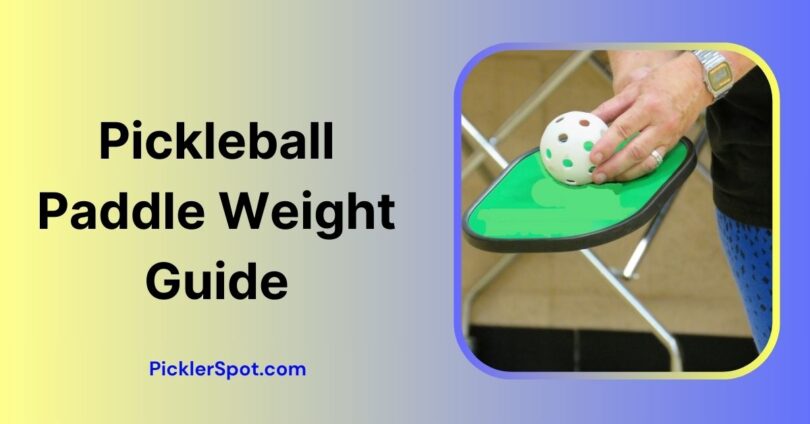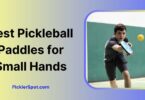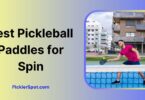Have you ever wondered why some Paddles weigh like a ton of bricks while some are so flimsy that they barely offer proper feedback? Well, you would be surprised to know that there is a whole host of logic behind the weight of a Paddle and it’s in fact kept intentional.
Each Paddle is designed to have its own purpose in the court so that it can align appropriately with the playstyle of an individual and even change the dynamics of the game.
If you are still feeling out of touch and cannot grasp the concept, then I would highly suggest skimming through my Pickleball paddle weight guide in which every aspect of the weight distribution is explained briefly.
Pickleball Paddle Weight Classification
In general, a Pickleball Paddle is classified into three sub-categories based on their weight,
1. Lightweight Class
These types of Paddles are often designed for players who are dealing with tennis Elbow and other forearm-related injuries. Usually, paddles being under than range of 7.0-7.8 ounces come under the tent of lightweight class and usually focus on precision and control when executing serves.
This sort of paddles excels exceptionally well in sensitive shots such as Dinks, Dropshots, and even groundstrokes which are often placed right across the feet of an opponent. Since lightweight paddles produce a more refined form of trajectory, you can easily control it with minimal effort.
Henceforth, lightweight Paddles are generally preferred by players who are getting into this sport or are learning the ropes.
But that doesn’t mean that advanced players are prohibited from its use cases, in fact, plenty of intermediate and professional players often use it to assist their manoeuvrability especially whenever they are Stacking in the court so they could more ground while requiring less energy.
Moreover, these categories of paddles are less strenuous on the arm, so if you are playing competitive leagues where the innings are more spread out, you might want to use lighter variants, since the fatiguing effect usually throttles a player’s capabilities.
2. Mid Tier Class
Mid-tier class Paddles are often preferred by both Professional and casual players and in fact, the go-to choice in the competitive leagues because it achieves the best of both worlds without sacrificing much. In other words, you are pretty much-getting Power and control all under the same roof.
On the flipside, due to their thickness, they are more likely to produce much more pop as compared to heavier paddles causing them to be more flexible and have more depth in their shots.
But then again, not all the glitters are gold here since you are also pretty much losing precision and control, and the situation is usually exacerbated especially if you lack the finesse to control your ball.
These Paddles usually weigh from 7.8-8.5 ounces and their weight is usually noticeable once you start swinging them in closed arcs, nevertheless for an individual who already has the skills to use these sorts of Paddles can comfortably carry them and execute deep drives with minimal effort.
3. Advanced Tier Paddles
These sorts of Paddles are all about Raw power and translate your brawns in the court since they usually weigh above 8.5 ounces and will be noticeably heavier regardless of your dexterity with your Paddles.
An individual using these paddles must be mindful of their swings as they will certainly drain a significant amount of energy.
However, the tradeoff here is that it usually has a much bigger sweet spot in comparison to the latter categories and tends to have much higher feedback ensuring a more profound form of accuracy in the trajectory of a shot.
Furthermore, the shots are usually flatter can be easily controlled, and often pack a punch, making them a go-to choice for those players who like to block shots while playing in defense or simply want to surprise their opponent through their aggressive approach by indulging in quick rallies, nevertheless, most of their shots would have much more raw power and flatter bounce rate.
These paddles are specifically made for professionals who have the stamina to last long on the court, otherwise even after a couple of rallies you would be pretty much grasping for breath.
How Does The Type Of Material Used Affect The Paddle Weight?
Typically, there are three types of Material used in the manufacturing of the paddle such as,
1. Graphite
These are often the lightest of the bunch and are quite flexible which is why paddles made from this material have more bounce frequency as well as Pop.
On the flip side, they are undoubtedly expensive and aren’t generally preferred by intermediate players.
In order to reap the most benefit out of graphite paddles all while keeping the price tag low, most manufacturers nowadays are crafting paddles that are made from more than one material i.e. Graphite and Carbon.
This blend ensures these hybrid paddles have more accuracy with precision without sacrificing speed while executing shots deep in the court.
However, most of the lightweight class Paddles you would see nowadays are purely made from graphite, including their shaft and frame, and are used for cover flanks, especially in duos format.
2. Fiber Glass
Carbon Fiberglass paddles are now considered a hot commodity and everyone wants to get their hands on them nowadays due to their amazing price-to-value ratio and low maintenance attribute.
They are also the most sought-after choice of players who likes to play in competitive league since they can be used for both defensive and aggressive playstyle.
Most of the paddles used aren’t that heavy, however, there are some instances where even the fiberglass paddles which tend to have broader sweet spots with massive width weigh more than 8 ounces.
3. Wood
Wooden Paddles are nowadays becoming rare and disliked due to their inconsistent nature since they lack flexibility and have a much flatter bounce rate. The apparent advantage here is that they usually are more budget-friendly and require little to no maintenance.
Some wooden paddles also include other material which is often integrated into their core, nevertheless, in terms of performance, accuracy, and power, they lag far behind the former materials mentioned above.
How Lead Tape Helps in the Weight Of A Paddle?
The probability of finding a paddle that is tailored to your needs is little to none, you might be lucky or have to go through plenty of trial and error in order to attain a paddle that aligns with your muscle memory.
This is why lead tapes play a huge role in the calibration of a Paddle so that it attains better swings or has a more profound form of sweet spot. You could apply lead tape on places such as,
- Top Face
- Throat
- Sides
- Corners
Bottom Line
Always remember, between these variants of Paddles that are subdivided on the basis of their weight, the right choice is often the one that suits your playstyle and assists your performance rather than acting as a hurdle.
To further elaborate, while lightweight paddles are much more easier to swing, they often lack the punch to excel the momentum into the ball so that it has more snappier speed.
That being said, hope my Pickleball paddle weight guide has been fruitful and worth the read, feel free to comment below if you have any queries relating to the Pickleball universe.









